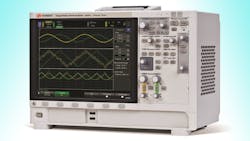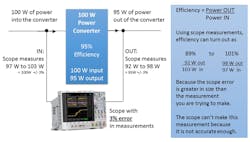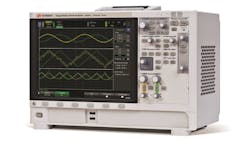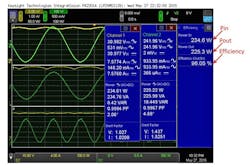This file type includes high resolution graphics and schematics when applicable.
Efficient use of energy is a key factor in many applications. For battery-powered applications, high efficiency means increased runtime, which in turn requires getting the most out of the battery’s limited resources. For grid-tied applications, efficiency means less heat generated, easing device design and enabling smaller devices, lower cost systems, lower operating costs, and a “greener” implementation.
Measuring efficiency, therefore, becomes critical in design. Often, such efficiency measurements require a high degree of accuracy. For example, to understand incremental improvements in designs, an R&D engineer may have to detect small changes in power to determine if the new design is achieving its goals to push up overall device efficiency. As efficiency approaches 90% to 100%, measuring the overall efficiency becomes quite challenging, as it becomes necessary to measure a very small difference (the lost energy) between two large numbers (power in and power out).
DC-DC Converter Efficiency
Under static conditions, it’s relatively easy to measure the efficiency of a dc-dc converter. Since the inputs and outputs are dc, and not changing (remember: static conditions), then you can use a DMM (digital multimeter) to measure the input voltage and input current and calculate input power. Similarly, you can use a DMM to measure output voltage and current and then calculate output power. With all measurements in steady state and dc, there’s no concern about skew between voltage and current or between input and output.
Once all measurements are made, either a manual calculation or a test program will be needed to collect the measurements and calculate efficiency. While this is not a complex operation, it’s not as convenient as having a single instrument that can measure all parameters at the same time and present the calculated efficiency as a reading on the display.
DMMs offer outstanding measurement accuracy and, therefore, will deliver high-accuracy efficiency measurements. For example, using a Keysight 34460A DMM, you have a basic measurement accuracy of 0.0025% for dc voltage and 0.007% for dc current. The resultant calculated efficiency can be on the order of 0.1%, depending on the voltage and current range.
AC-DC, DC-AC or AC-DC Power-Converter Efficiency
When any of the inputs or outputs to the power converter is an ac signal, the DMM method will not always work. Voltage and current will most likely not be in phase. Current waveforms will not be sinusoidal, which makes it a challenge to measure RMS.
Simultaneous and accurate RMS measurements of voltage and current must be made to measure real power and, subsequently, calculate efficiency. To get the most accurate efficiency, you also need to make sure that the input and output power are simultaneously measured to ensure that you’re comparing the input and output during the exact same time window and operating conditions.
Efficiency-Measuring Oscilloscopes
A four-channel oscilloscope seems to be a good tool to measure efficiency. Most certainly, all four channels will simultaneously measure input voltage, input current, output voltage, and output current. Oscilloscopes have more than enough bandwidth to measure ac power signals.
However, oscilloscopes are typically ground-referenced, which could be a challenge when measuring certain power converters. Thus, they may require differential voltage probes. And to measure current, current probes will need to be added.
Another important accessory is software. Many oscilloscope companies provide software options to their oscilloscopes to simplify setup and calculation of power measurements like efficiency. For example, Keysight Technologies offers the DSOX4PWR Power Measurements for the InfiniiVision 4000 X-Series Oscilloscopes, which adds over 20 power measurements, including efficiency, to the oscilloscope.
While the oscilloscope can be outfitted with probes and software to measure efficiency, it does have some limitations. In general, an oscilloscope has about 3% error in its vertical measurements due to both the oscilloscope’s gain error and the current probe error. As a result, the scope will struggle to accurately measure efficiencies over 90% or see incremental changes of 5% or less in efficiency.
Figure 1 shows an example of an oscilloscope that has 3% measurement error. Due to this error, you get a wide range of power measurements, with a resultant calculated-efficiency range of 12% (± 6%) error. If you were designing a 95% efficiency converter, and attempted to raise its efficiency to 96%, you would not be able to tell if you had made an improvement. That’s because the 1% improvement in efficiency would be lost in the efficiency error band of ±6%.
Power Analyzers to Measure Efficiency
A preferred method for measuring power-converter efficiency is to use a power analyzer. These instruments are specifically designed to make very accurate, simultaneous measurements of voltage and current. Multichannel analyzers can simultaneously measure both input and output power on a single-phase or multiphase ac or dc signal. Most power analyzers are floating, able to measure hundreds of volts without differential probes, and measure current directly.
For instance, Keysight’s PA2201A IntegraVision Power Analyzer (Fig. 2) is one such instrument that can easily measure power-conversion efficiency with high accuracy (Fig. 3). Dynamic measurement capability makes it possible to capture and display transient voltage, current, and power waveforms; thus, critical power measurements can be performed with one instrument. When using a power analyzer, power-conversion efficiency measurements should have accuracy of 0.25% to 0.5%.
In today’s ever-increasing energy-conscious world, engineers must reduce product power consumption and improve overall product efficiency. Accurate measurement of power-conversion efficiency is paramount for reducing energy consumption. A DMM could be used, but only for dc signals and it won’t provide a direct power measurement. Oscilloscopes capture waveforms with excellent bandwidth but have limited vertical accuracy, are earth ground referenced, and have no direct current measurement capability. A power analyzer with built-in efficiency measurement capability provides the best method for easily and accurately evaluating power consumption.
About the Author
Bob Zollo
Solution Architect for Battery Testing, Electronic Industrial Solutions Group
Bob Zollo is solution architect for battery testing for energy and automotive solutions in the Electronic Industrial Solutions Group of Keysight Technologies. Bob has been with Keysight since 1984 and holds a degree in electrical engineering from Stevens Institute of Technology, Hoboken, N.J. He can be contacted at [email protected].






